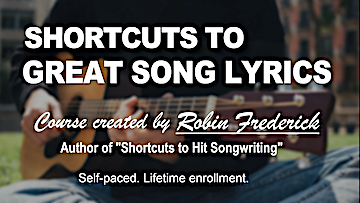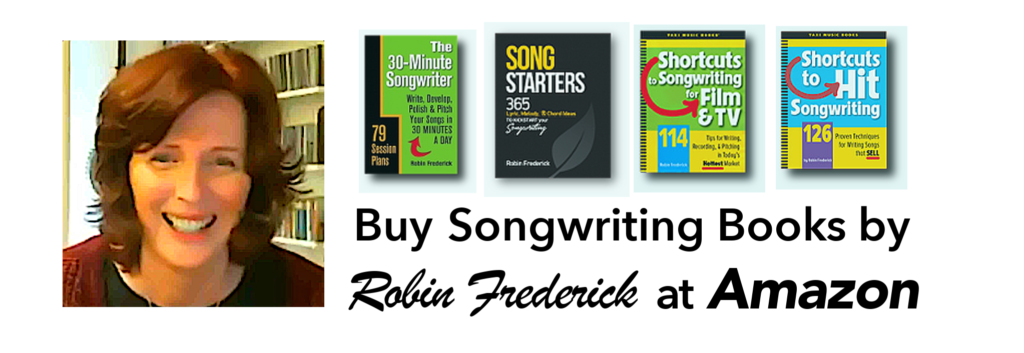When NASA blasts a rocket into orbit, they do it in stages: The big lift-off, a second stage to get the payload into orbit and a third to fine tune the direction. So, what’s this got to do with writing lyrics? You can think of the lyric writing process in three stages:
- 1. Getting started. (Lift off)
- 2. Developing your idea. (Getting into orbit)
- 3. Rewriting (Fine tune it)
=> STAGE ONE: GET STARTED
BEGIN WITH A TITLE
Starting the lyric writing process with a title can give you a beacon that will keep your song lyric focused. That’s very important if you want to keep listeners involved. Any short phrase you find emotionally intriguing—or simply an honest statement of how you feel—can work as a title. Make it something you want to write about.
Then make a list of questions the phrase suggests. These are the questions you’re going to answer in your song. Try questions like: What does this mean? Why do I need to say it? How does it feel? How did it happen? What do I think the consequences will be? Every phrase suggests different questions. And every songwriter will find different ones to ask.
OR… you can start writing the first line of your song and work from that. Let’s say you overhear a line in conversation that sounds interesting or a line occurs to you that triggers a whole string of thoughts. Write everything down, then go back and look it over. Do you know what this song is about? Can you put the lines in some kind of order that develops an overall idea? By the time you write the second line of your first verse, you should have an idea where your song is headed.
=> STAGE TWO: DEVELOP YOUR IDEA
Decide on your song structure. For most songs, it’s a good idea to write in a form that has a chorus section, such as…
VERSE / CHORUS
VERSE / CHORUS
BRIDGE / CHORUS. (Read more about song structure.)
FEATURE YOUR TITLE IN THE CHORUS
It’s a good idea to put your title in the first line or last line of your chorus, or use it in both places. It will provide an anchor for your listeners, a focal point, so a little repetition is a good thing. Surround your title with lines that support it. For example, you might choose to answer the question you feel is the most important. Or describe the emotions that are going on.
Remember, the chorus sums up the heart of your song. Be sure to keep it focused on a peak emotional moment. Don’t try to explain too many specific ideas in the chorus. Save that for the verses.
LAY OUT YOUR VERSES AROUND THE CHORUS
Choose at least one of the questions from your list to answer in each verse and the bridge. By laying out your song instead of just writing whatever comes to you, you’ll stay focused on a single idea in each verse and you won’t wonder what you’re going to write about when you get to the bridge!
FILM & TV SONG TIP: If you’re writing songs for the film & TV market, keep the focus solely on a peak emotional moment and try to avoid a specific storyline. The script will take care of the story details. Also, for film & TV, the VRS / VRS / BRIDGE / VRS song form can work well. Try using your title in the last line of each verse. If you repeat that last line each time the verse comes around, it will add weight and create a chorus-like feel.
Find out more about writing songs for Film and TV.
=> STAGE THREE: REWRITE AND POLISH
Fill in more lines around the ones you’ve written. Simple, conversational phrases are fine but you might want to mix these with images, comparisons, and physical expressions of emotion to make your listeners really feel it! Don’t just tell them what you experienced; make them experience it, too.
Replace a cliché with a fresh idea. If you’ve written a line that listeners have heard a thousand times, try adding a twist, end the phrase in a different way than we expect.
PUNCH UP YOUR LANGUAGE
If you wrote “I need…” try “I hunger…” or “I crave…” Make your action words work harder, too. Instead of “you walked away,” use “you slipped away” or “you danced away.” These words tell us more about the emotions that accompanied the action.
Go through your lyric and make certain you’ve answered the important questions about the situation. Did you say something in your lyric that raised more questions or hinted at something else? You’ve got to deal with that—either answer the question or change that line. You don’t want to leave the listener feeling unfulfilled.


WHAT ABOUT RHYMES?
This is the time to “encourage” some rhymes. Don’t force them; never change the natural word order of speech to accommodate a rhyme – you’re likely to lose the believability of the lyric. Look for a rhyme that feels easy and natural. if you use “vowel rhymes” you have a huge selection to choose from. Like the name implies “vowel rhymes” merely rhyme the vowel sound. Fine/time, now/house, love/stuff are all vowel rhymes. Check out RhymeDesk.com or B-Rhymes.com for lists of near rhymes. (Read more about rhyming.)
ONE LAST THOUGHT…
At times during the lyric writing process, there’s likely to be a strong line that “just occurs to you,” a line you reeeeally want to use. If you laid out your song as a rough sketch first, take a look to see where the line might belong and put it there. If it doesn’t seem to belong to any section, then it might provide the germ of a new song. Write it on a separate sheet of paper and put it to one side. You can come back to it later to see where it leads. In songwriting, no good line is wasted – you just have to find the right place for it.

